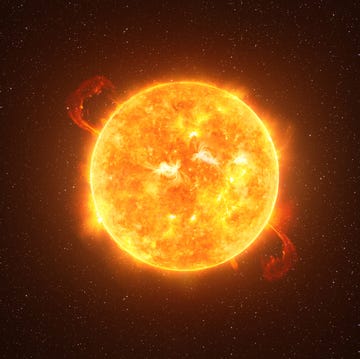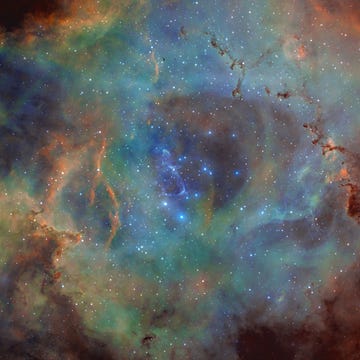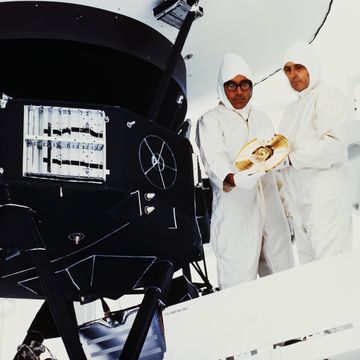Back in 2002, John Moore, an anthropologist at the University of Florida, calculated that a starship could leave Earth with 150 passengers on a 2000-year pilgrimage to another solar system, and upon arrival, the descendants of the original crew could colonize a new world there—as long as everyone was careful not to inbreed along the way.
It was a valiant attempt to solve a thorny question about the future of humans in space. The nearest star systems—such as our nearest neighbor, Proxima Centauri, which is 4.2 light-years from home—are so far that reaching them would require a generational starship. Entire generations of people would be born, live, and die before the ship reached its destination. This brings up the question of how many people you need to send on a hypothetical interstellar mission to sustain sufficient genetic diversity. And a new study sets the bar much higher than Moore's 150 people.
According to Portland State University anthropologist Cameron Smith, any such starship would have to carry a minimum of 10,000 people to secure the success of the endeavor. And a starting population of 40,000 would be even better, in case a large percentage of the population died during during the journey.
At the moment, NASA isn't ready to send human explorers to Mars, let alone out of the solar system. But some private organizations, including the federally funded 100 Year Starship project, plan to make manned interstellar travel possible within the next century, hoping that a huge increase in propulsion speed could reduce the travel time between stars to just a few hundred years. Icarus Interstellar, one of the groups involved in 100 Year Starship, asked Smith to make this calculation of how many passengers would be needed to keep that population healthy. The results are published in the April–May issue of Acta Astronomica.
"I did this study to materially help in putting together the millions of puzzle pieces that will be required to allow humanity to spread out from our earthly cradle," he says.
William Gardner-O'Kearney, who studied archaeology at Portland State, helped Smith build the MATLAB simulations to calculate how many different scenarios would play out during interstellar travel. He ran some additional simulations specially for PopMech to show us why the success of an interstellar mission depends crucially on the starting population size.
Gardner-O'Kearny calculated each population's possible trajectory over 300 years, or 30 generations. Because there are a lot of random variables to consider, he calculated the trajectory of each population 10 times, then averaged the results. (With one exception: The starting population of 40,000 is so large that it takes 18 hours to complete each simulation, so he calculated that trajectory only once.)
Genetic diversity keeps groups healthy, and larger populations tend to have more diversity. In small or isolated groups, including Ashkenazi Jews and the Amish, marriage between relatives has reduced genetic diversity and made otherwise rare diseases such as Tay Sachs and cystic fibrosis common among those populations. Graph A shows that Moore's suggestion of 150 people is not nearly high enough to maintain genetic variation. Over many generations, inbreeding leads to the loss of more than 80 percent of the original diversity found within the hypothetical gene.
A population of 500 people would not be sufficient either, Smith says. "Five hundred people picked at random today from the human population would not probably represent all of human genetic diversity . . . If you're going to seed a planet for its entire future, you want to have as much genetic diversity as possible, because that diversity is your insurance policy for adaptation to new conditions."
A starting population of 40,000 people maintains 100 percent of its variation, while the 10,000-person scenario stays relatively stable too. So, Smith concludes that a number between 10,000 and 40,000 is a pretty safe bet when it comes to preserving genetic variation.
The second threat to interstellar voyagers is catastrophes—plague, war, collisions, and mechanical failures—that could wipe out large portions of the population at any time.
The population of 40,000 can take quite a hit but still manage to stay within the range of a healthy population size, and the 10,000-person starship survives pretty well too.
To check out the smaller populations, we need to zoom in:
The population of 2000 gets halved over time, which is not good. And though the smaller populations (150 and 500) look as if they survived better, that's partially because those populations had to have looser birth restrictions: Whereas in the simulations, the larger populations were allowed to have only one child per couple, the smaller populations allowed a couple to have two or three children to ensure the survival of the community. In the end, the growth cancelled out the disastrous effects. And if we take a look at the original 10 simulations for the 150-person starship (see graph below), we can see that three of the populations were totally wiped out. For 500 people, only one population got wiped out, and the risk of a wipeout gets smaller as population size goes up. The takeaway is that for both factors (genetic diversity and catastrophe survival), bigger populations are better.
Luckily, tens of thousands of pioneers wouldn't have to be housed all in one starship. Spreading people out among multiple ships also spreads out the risk. Modular ships could dock together for trade and social gatherings, but travel separately so that disaster for one wouldn't spell disaster for all, says Smith.
When 10,000 people are housed in one starship, there's a potential for a giant catastrophe to wipe out almost everyone onboard. But when 10,000 people are spread out over five ships of 2000 apiece, the damage is limited.
To make interstellar travel a reality, scientists and engineers will have to overcome huge obstacles. They'll need to find ways to increase propulsion speed, prevent the negative health effects that arise from living in space, and devise self-sustaining systems that provide food, water, and air. At least the new calculations provide some sort of starting point.
"With 10,000," Smith says, "you can set off with good amount of human genetic diversity, survive even a bad disease sweep, and arrive in numbers, perhaps, and diversity sufficient to make a good go at Humanity 2.0."














